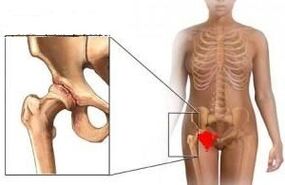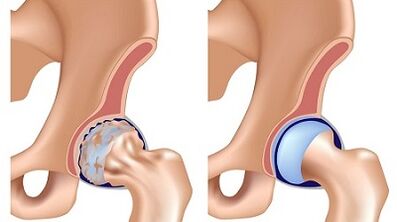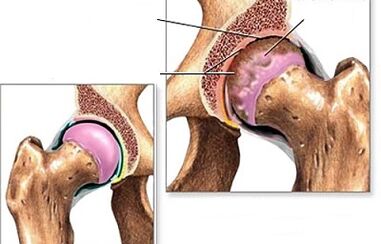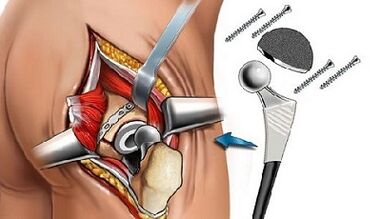
The hip joint arthrosis is a severe pathology that develops in the hip joint as a result of nutrition and, as a result, the destruction of cartilage tissue and the ability of the thigh.
With healthy cartilage tissue, the joint is easily moved and does not cause discomfort.If the cartilage is damaged by arthrosis, the surface is no longer smooth, then there is a zabina, fossa, which makes the joint bend/extension difficult.The thigh becomes like the rusty loops of the garden gate, which opens squeaks and feels tension as it moves.
The disease is dangerous that, when the treatment begins early, the cure is not only impossible, but the disease process leads to further mobility and joint losses.
Reasons
What is it?Coksartrosis develops for many reasons, the most important is the sedentary lifestyle.Athletes are most often suffered from this disease due to heavy loads, which can hurt the joint.Unfortunately, arthrosis is often inherited, and congenital dislocation is possible in the inguinal region.
Causes of provoking the development of ciscartrosis of the hip joint:
- Pertes disease;
- fracture of the thigh neck;
- injuries or microtrauma in childhood;
- Overweight, heavy load;
- alcohol consumption;
- congenital diseases;
- increased hormone levels (age -related changes);
- tissue inflammation;
- Destruction of joint tissues;
- taking strong medicines;
- stressful situations;
- infectious and inflammatory processes;
- Pathological Diseases in the inguinal region.
Particular attention should be paid to the presence of injuries (microtrauma).They heal for a long time, which leads to the development of the disease for years.Most often, the disease begins with people 40 years of age or older.Inflammation begins with a hip joint, but if it does not use treatment on time, the disease will apply to other areas.
Symptoms of arthrosis of the hip joint

Coksartrosis is most often developed in people over 40 years of age.It progresses gradually and a person's condition deteriorates year by year.If you do not treat the damaged joint, after a while, pathological changes can enter another joint.
In world practice, it is recognized that there are three stages or developmental stages of arthrosis of the hip joint.Each is characterized by their own symptoms.
1 degree of arthrosis of the hip joint
At this stage of the disease, one experiences only physical effort and post -pain, from long -term running or walking, while the joint pain is primarily painful, very rarely pain causes pain in the thigh or knee.
At the same time, however, man's walk is normal, chrome is not observed, and the hip muscles are not atrophy.When diagnosed with images, the bone growth, which is located around the inner and outer edges of the acetabulum, is observed and other abnormal disorders of the cervical and femur heads have not been observed.
2 degrees of hip joint is the hip joint
With the arthrosis of the hip joint, the symptoms become significant, and the pain is already constant and more intense, and during rest and movement, both in the groin and the comba, the patient is already affected.There is also a thigh restriction, and the amount of hip movements is reduced.
In the images, the narrowing of the gap becomes half from the norm, the growth of bones in the outer and inner winds of the head of the head starts to grow, deformed and shift, and its edges become uneven.
3 degrees for the arthrosis of the hip joint
At this stage of the disease, the pain is painful permanent nature, both during the day and at night, the patient should be difficult to move, so a reed or crutch can be used, the amount of joint movement is very limited, the lower leg, the hips and the buttocks are muscular atrophy.
The foot is shortened and the man is forced to decide the body when the sick foot walks.Based on the center of gravity, the load on the damaged joint is increasing.The X -Gay images find more bone growth, the thigh head expands, and the joint gap is significantly narrowed.
Diagnosis
Diagnosis is based on anamnesis data (identification of risk factors or causal diseases), clinical data and complementary test methods.

Clarification of the diagnosis and performing differential diagnosis will help:
- X -tumor of the hip joints;
- Ultrasound of joints;
- MRI or CT.
As a general rule, you should make an accurate diagnosis, sufficient clinical and radiological examination.X -rays contain specific changes in each stage of the disease: narrowing of the articular gap, presence of osteophytes, displacement and deformation of the femoral head, subchondral cysts and periarticular osteosclerosis, osteoporotic changes in bones.Depending on the presence and severity of pathological changes, the degree and stage of the disease shall be agreed.
Treatment of joint joints of the hip joint
In the first phase, the arthrosis of the hip joint perfectly lends to conservative treatment.The most important task is to relieve pain, which prevents the patient from movement.
In the process of coxarthrosis therapy ::
- Restoration of nutrition and blood circulation in muscle and cartilage;
- The physical activity of the injured joint is reduced;
- restoration of damaged cartilage;
- Activation of the hidden reserves of the human body, which contributes to tissue regeneration at the microchellular level;
- increase in joint gap;
- Restoring joint mobility.
During drug treatment, the following drugs are prescribed in this category of patients:
- No -steroid anti -inflammation.They help to eliminate pain and remove the developed edema and inflammation, but their uncontrolled use contributes to suppressing the natural restoration of the cartilage.Doctors do not recommend using more than one non -sertoid medication at the same time;
- Relaxing muscles.Remove muscle cramps, increase blood supply to the joints, but their use should be under the supervision of your doctor for side effects;
- Expanding ships.They are able to relax the smooth muscles and increase the space between the muscles.They have a minimum contraindications, but their efficiency is an individual index;
- Steroid type.Help simultaneous diseases such as inflammation of the thigh bone, but has many side effects;
- Recovery of cartilage.Condroprotectors are the most useful for joint deformation.The cartilage is nourished with the desired elements and stops the disease;
- Local use.The main positive effect is to rub the products into the skin, which relieves muscle cramps and promotes the improvement of blood circulation.
During conservative treatment, patients should follow the meal, which is specifically designed for patients with arthrosis of the hip joint.The course of therapeutic therapy includes the therapeutic massage, which is presented to patients with 1 and 2 stages of arthrosis.
Endoprostics

The third stage of the disease only leads to surgical treatment.The patient is recommended to replace the joint or endoprostanism.The surgeon cuts off the head of the thigh, inserts a metal tap into the cut, which fixes the artificial head.
The prosthesis itself is unique (replacing the head only) and all (replacing both ingredients).The next day, after surgery, some elements of the exercise are performed in bed, the patient can stand up, but so far at the foot, after a few days on the crutches.After 2-3 months, the crutches will not be required, the total load of the foot will be allowed.
Patients recommended for rehabilitation who are underoprosticated and consist of physiotherapy exercises, massage course and physiotherapy.In most cases, the limb function is restored.The prosthesis has a service life of 10-20 years and then replaces a new one.
Gymnastics with the joint joint of the hip joint
The exercises for the struggle and prevention of coksartrosis should be carefully performed.Exercise therapy should be smooth and do not cause pain.LFK for treating the disease should be focused primarily on strengthening the muscles themselves and filling the joints.A good way to prevent coksartrosis is swimming, especially in salt water.
- Beginner position: lie on the floor, stretch your arms and legs along the body.Slowly lift your sore leg in the knee joint, 15 cm from the floor and hold for approx.For half a minute.Then lower your leg and repeat the exercise with another leg;
- Beginner position: Lie on your stomach, stretching legs and arms along the body.Raise the straight legs 15 cm up, prepare and divide them to the side.Everything has to be done slowly.
Keep in mind that some exercises with arthrosis of the hip joint may be difficult due to exercise due to exercise.These are quite effective methods for preventing various diseases, so the physical practice system includes both arthrosis and other diseases.
Folk medicines
There are many successful methods for treating coxarthrosis in folk medicine:

- Inward tinctures and decoctions (many recipes are available for preparation of healing folk medicines, which include garlic, lemon, mummy and various parts of plants, and honey, etc.);
- Ointment on various natural parts (celandine, eucalyptus oil, aloe and other plants);
- Compression and bathtubs (introduction of cabbage bases, baths Jerusalem artichoke and so on).
The use of all folk drugs should be remembered that there is no guarantee of 100 % healing.
Prevention
Prevention measures are very important, especially when the hip joint dysplasia, fractures, severe bruises or confusion in this area.
- Body weight control (reduce flour products, table salt, sweet, strong tea and coffee in the diet).In predominance, the risk of arthrosis of the hip joint is increased.
- Exception of weight transfer, jumps (especially from heights).Try not to hold on your feet for long.
- If there are diseases that are related to metabolism (diabetes, atherosclerosis), they should be compensated.
- Dosed physical exercises to strengthen the muscles of the hips and the bottom (cycling or cycling, swimming, therapeutic gymnastics).
Adherence to preventive measures, early detection and proper treatment of coxarthrosis is the key to a positive prognosis of the disease.























